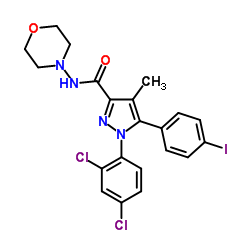AM281

AM281 structure
|
Common Name | AM281 | ||
|---|---|---|---|---|
| CAS Number | 202463-68-1 | Molecular Weight | 557.212 | |
| Density | 1.7±0.1 g/cm3 | Boiling Point | N/A | |
| Molecular Formula | C21H19Cl2IN4O2 | Melting Point | N/A | |
| MSDS | Chinese USA | Flash Point | N/A | |
| Symbol |

GHS06 |
Signal Word | Danger | |
Use of AM281AM281 is a selective CB1 receptor antagonist with an IC50 of 9.91 nM. AM281 inhibits CB2 receptor with an IC50 of 13000 nM[1]. |
| Name | 1-(2,4-dichlorophenyl)-5-(4-iodophenyl)-4-methyl-N-morpholin-4-ylpyrazole-3-carboxamide |
|---|---|
| Synonym | More Synonyms |
| Description | AM281 is a selective CB1 receptor antagonist with an IC50 of 9.91 nM. AM281 inhibits CB2 receptor with an IC50 of 13000 nM[1]. |
|---|---|
| Related Catalog | |
| Target |
CB1:9.91 nM (IC50) CB2:13000 nM (IC50) |
| In Vitro | AM281 (0.01-10 μM) promotes a concentration dependent increase in 10 μM Aβ 25-35 induced neurotoxicity in SH-SY5Y cells in the presence of 10 μM KSO 1-6[2]. |
| In Vivo | Acute administration (2.5, 5 and 10 mg/kg) of AM281 shortens exploration time and improves memory performance, as does chronic administration (0.62, 1.25 and 2.5 mg/kg) of AM281[3]. Chronic administration of AM281 at 2.5 mg/kg improves recognition index to the 22.1±4.8 and single dose of AM281 at 5 mg/kg improves the memory impairment to the 8.5±4, as compared with vehicle-treated which is 4.8±2.5. Administration of AM281 at a dose of 2.5 mg/kg in chronic form and 5 mg/kg in acute dose improve memory[3]. Animal Model: Male NMRI mice with the weight of 25-30 g[3] Dosage: 0.62, 1.25 and 2.5 mg/kg (chronic administration); 2.5, 5 and 10 mg/kg (acute administration) Administration: Administrated i.p. every day concurrently with morphine except the day of experiment (chronic administration); Singly injected 40 min before second trial (acute administration) Result: The simultaneous daily administration of AM281 with morphine significantly shortened the exploration time, as compared with morphine-dependent mice receiving vehicle. Acute administration at a dose of 5 mg/kg, significantly augmented recognition index. |
| References |
| Density | 1.7±0.1 g/cm3 |
|---|---|
| Molecular Formula | C21H19Cl2IN4O2 |
| Molecular Weight | 557.212 |
| Exact Mass | 555.992981 |
| PSA | 59.39000 |
| LogP | 4.90 |
| Index of Refraction | 1.706 |
| InChIKey | AJFFBPZYXRNAIC-UHFFFAOYSA-N |
| SMILES | Cc1c(C(=O)NN2CCOCC2)nn(-c2ccc(Cl)cc2Cl)c1-c1ccc(I)cc1 |
| Storage condition | 2-8C |
| Symbol |

GHS06 |
|---|---|
| Signal Word | Danger |
| Hazard Statements | H300-H315-H319-H335 |
| Precautionary Statements | P261-P264-P301 + P310-P305 + P351 + P338 |
| Personal Protective Equipment | Eyeshields;Faceshields;Gloves;type P2 (EN 143) respirator cartridges |
| Hazard Codes | T: Toxic; |
| Risk Phrases | R25 |
| Safety Phrases | 26-36/37/39-45 |
| RIDADR | UN 2811 6 |
|
Cannabinoid agonists rearrange synaptic vesicles at excitatory synapses and depress motoneuron activity in vivo.
Neuropharmacology 92 , 69-79, (2015) Impairment of motor skills is one of the most common acute adverse effects of cannabis. Related studies have focused mainly on psychomotor alterations, and little is known about the direct impact of c... |
|
|
Activation of CB2 receptor is required for the therapeutic effect of ABHD6 inhibition in experimental autoimmune encephalomyelitis.
Neuropharmacology 99 , 196-209, (2015) Alpha/beta-hydrolase domain 6 (ABHD6) is a novel 2-arachidonoylglycerol (2-AG) hydrolytic enzyme, that can fine-tune the endocannabinoid signaling in the central nervous system. Recently we and others... |
|
|
Cannabinoid receptor 1 inhibition improves the intestinal microcirculation in experimental endotoxemia.
Clin. Hemorheol. Microcirc. 58(2) , 333-42, (2014) Impairment of the intestinal microcirculation in endotoxemia may cause a deterioration of the mucosal barrier function thus releasing intraluminal bacteria and their toxins into the systemic circulati... |
| AM 281 |
| 1H-Pyrazole-3-carboxamide, 1-(2,4-dichlorophenyl)-5-(4-iodophenyl)-4-methyl-N-4-morpholinyl- |
| Tocris-1115 |
| S1595_Selleck |
| 1-(2,4-Dichlorophenyl)-5-(4-iodophenyl)-4-methyl-N-(morpholin-4-yl)-1H-pyrazole-3-carboxamide |
| MFCD01861180 |
| 1-(2,4-Dichlorophenyl)-5-(4-iodophenyl)-4-methyl-N-(4-morpholinyl)-1H-pyrazole-3-carboxamide |